PivotPro Golf Training Aid
PivotPro is the first pivot training aid for golfers of all caliber and ages. With its easy to use and versatile design, PivotPro is a revolutionary golf training aid that is specifically designed to promote correct pivoting in your golf swing. Learn to Pivot Like The Pros, with the PivotPro - Load Properly & Stop Swaying.
The secret to PivotPro success is that it forces you to pivot correctly ingraining correct fundamentals resulting in proper coiling of the upper torso against the rig ht leg, creating maximum resistance that leads to more power, consistency, proper weight distribution, and footwork, its like having your own professional instructor.

| PivotPro Will Fix Your Golf Swing |
| * |
Excessive Sway - swaying hips result in a poor weight shift, and power loss |
| * |
Over the Top Move - It prevents casting of the club and over the top move |
| * |
ReversePivot- If you suffer from reverse pivoting, lack of club head speed or a balanced finish. |
| * |
Master to stay centered over the ball. |
| * |
Master to swing the club on the correct plain. |
| * |
Master a powerful coil. |
| * |
Master your spine angle. |
| * |
Master proper footwork and balance. |
| Jim McLean Sees The Benefits of Using the PivotPro Swing Trainer |
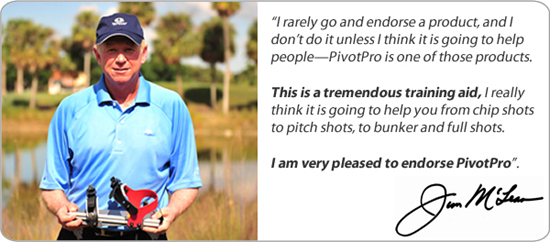
|
Jim McLean Endorses PivotPro
Jim McLean is the 1994 PGA National Teacher of the Year, owner of the Jim McLean Golf Schools.
Jim is probably best known for his research on the golf swing and his work on The X-Factor, which describes in detail, body motions, body angles and body positions. The X-Factor and Y-Factor are just a few terms Jim has coined over the last 3 decades of golf research. |
Click Here to to watch Jim McLean discuss more benefits of the PivotPro swing trainer.




| The Pivot Pro Golf Training: |
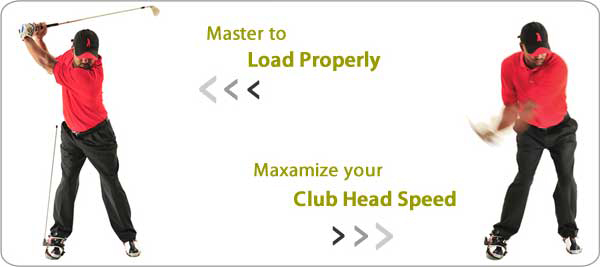
Many golfers don't even realize that they are swaying during their golf swing. What is a sway and how can it affect your golf swing?
A sway is the sideways movement of your hips during the golf swing or the lateral movement of center of your balance. In other words, your center of gravity shifts outside your right foot or it can be a combination where your right hip moves laterally outside you right foot and your upper body leans back towards the target.
Swaying in a golf swing - Number One Mistake Golfers make
Most golfers, who sway, also lock their back knee during the back swing. The locked knee forces the body to lean back towards the target, producing a reverse pivot- as shown in the picture above.
The problem is compounded if you don't address the root of the problem. If you try to address the reverse pivot without correcting the knee or the sway, the problem will, and often does return....leaving you frustrated.
In addition, the sway also puts the back hip in a position that does not allow a full body turn during the back swing, which forces a golfer to swing the club using his/her arms and will in most cases result in a over the top golf swing that is not powerful and is hard to time.
The golf swing is a chain reaction and demands balance, coordination and timing. How you start the swing will determine the end result. In order to achieve smooth, powerful and repeatable swing, your first move away from the ball - or to put it simply, the first link in the chain is absolutely critical. |
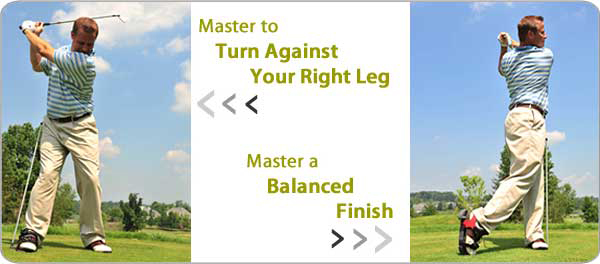
Professional golfers transfer 90% of their body weight to the back leg during the back swing, while amateurs transferred only 50% at the top of the swing.
Correct Pivoting in golf Swing Stop Tilting, Start Loading Properly for Better golf Shots and Less Back Pain
It is one thing to know that you revers pivot, but it is a whole another thing to learn how to pivot correctly. You've practiced, you've taken lessons and you have spent thousands of dollars on the latest equipment, but you still haven't improved your golf game. Maybe it is time to have a closer look, at how well your body is pivoting, in order to become a more consistent player. Improving your strength, flexibility, coordination and balance will sure help you, but it won't do you any good if you don't learn and practice to pivot correctly. |
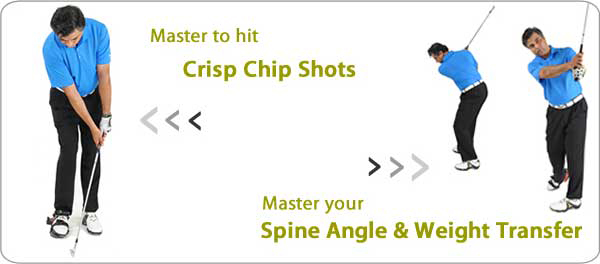
How to Pivot Correctly with PivotPro?
SETUP
First, standup straight and spread your feet shoulder-width apart, start to bend from the waist, and at the same time feel that you stick your backside. Sense that you are getting ready to catch a ball or you are easing yourself to sit down on a high chair.
SIMPLY RELAX
Easier said than done. However, here is a trick I learned from a pro. Try relaxing your neck muscles by relaxing your lower jaw and slightly sticking your tongue out - try it - feel the tension going away in your arms. Keep the same relaxed feeling throughout your swing.
Another good way to relax is to start from your finger and hands up. Imagine you are holding a child's hand. This will result in relaxed shoulders, chest and back muscles.
KEEP YOUR HEAD UP
Keep your head up away from your chest, this can be accomplished by seeing the ball down your nose. If you suffer from reverse pivot, make sure you keep your chin up; this will give you more room to turn your left shoulder behind the ball facing the target.
PRETTY PICTURE
I suggest that you rehearse your next moves in front of the mirror so that you can compare how you feel when you are getting in a correct position or pivoting correctly.
TAKEAWAY
Start with your arms, sweep the club head away from the ball 'wide and slow' feel that your left shoulder is pulling away from your chin, and your left hip and left knee is slightly moving inwards towards the ball - this leads to the next very important turning move. Practice this move until you are used to correct feeling and proper positions - this is what is referred to as a one-piece takeaway.
Try to keep everything together, avoid independent hand, hip or body motion. When practiced properly this will give you added width in your golf swing.
Tip: Keep the club head moving straight back for the first 18 inches or so - this will ensure that your club gets on a correct path.
If done correctly you will notice that your left forearm will rotate naturally (Provided your grip is correct).
Make sure that you are completely relaxed at this point, continue to swing, let your wrist hinge naturally until your left arm is horizontal to the ground and your club is at a 90 degree pointing skywards. At this point your wrist is fully hinged and your left arm is fully extended. (Practice this move in front of the mirror, until you feel comfortable).
GETTING IN THE SLOT
At this stage one thing to look for and practice repeatedly is to make sure that the butt-end of the club shaft is pointing towards the ground approximately mid-way between your feet and the ball â€" this is absolutely critical in order to get your club going on a correct plane.
PIVOT FOR POWER
At this stage of the swing, make sure that you are turning against your right leg (just a reminder keep your right knee flexed). The feeling you want to have is that your upper torso and majority of your body weight is flowing towards the right side without swaying your hips. Imagine if you were wearing a necktie - at the top of your swing the tie will hang over or slightly inside your left foot. Now, you are properly and fully loaded. As you practice this move, you should feel the tension inside your right leg. Make sure that you retain the flex in your right knee - if your leg straighten, your back swing will lose all the control and power.
ALL THE WAY TO THE TOP
Now, all you have to do is crank your shoulders until your back is facing the target, this will put the club the perfect position at the top, with the shaft parallel to the target line.
Remember, keep the right knee flexed, this stops the right side from swaying or spinning out of control. This move when performed correctly, will result in maximum resistance, which translates into more power.
Practice this move in your home, office with PivotPro, with the rod inserted into the device. Rehearse the last two stages of the swing as often as possible. Get yourself into the half-way back position, with your wrist hinged and club facing skywards at a 90 degrees angle, and simply completing your backswing by turning your shoulders to the finished backswing. |
| Pivot Pro FAQS |
 What all shoe sizes does PivotPro accommodates? What all shoe sizes does PivotPro accommodates?
PivotPro's versatile design is fully adjustable and can accommodate shoe sizes 7 through 14.
Do you offer PivotPro for Left Handed players?
Unfortunately, PivotPro is not available for left hand golfers at this time. However, we are actively working on bringing PivotPro for left handed golfers in a near future.
Can I hit full shots with PivotPro?
Absolutely YES, PivotPro unique and versatile design allows you to practice full shots. PivotPro's unique design allows you to practice virtually anywhere you like. Practice in your backyard, office, home or at the driving range. (Please read instruction sheet provided with your PivotPro for safe practice).
How can PivotPro help me with my chipping?
PivotPro forces you to put majority of your weight (approx. 70 - 30) onto the left foot. A major factor in hitting consistent chip shots is for the hands to lead the clubface through impact. Place the ball towards the back of the stance and your hands ahead of the ball this will force you to keep the hands ahead of the ball and not allow your wrist to dominate the shot. It will also help you stay centered and hit chip shots with the correct downward strike.
Can I practice with PivotPro in my office or home.
Yes, however please use PivotPro in a room wide enough to swing the golf club. Only use PivotPro on a carpeted surface, which is either glued, or one that is installed from wall-to-wall and is secured with tension strips.
|
|





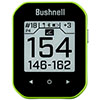


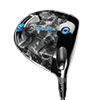


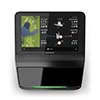


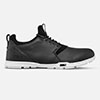











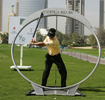





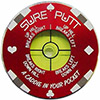


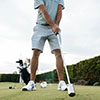






















 What all shoe sizes does PivotPro accommodates?
What all shoe sizes does PivotPro accommodates?











